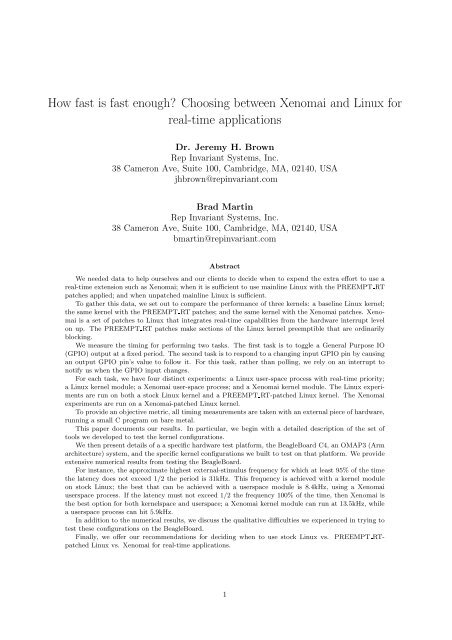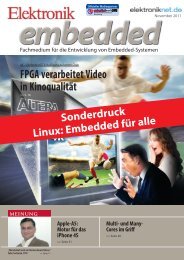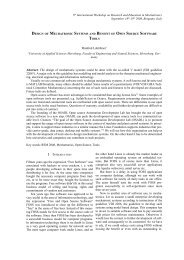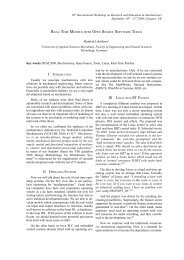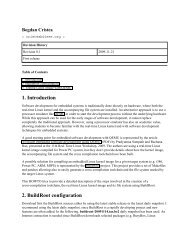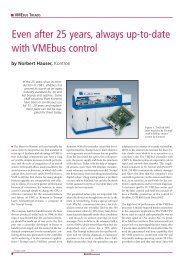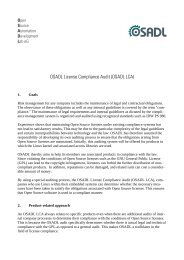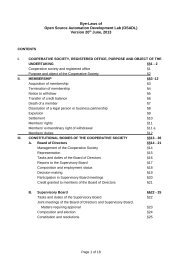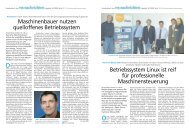How fast is fast enough? Choosing between Xenomai and ... - OSADL
How fast is fast enough? Choosing between Xenomai and ... - OSADL
How fast is fast enough? Choosing between Xenomai and ... - OSADL
You also want an ePaper? Increase the reach of your titles
YUMPU automatically turns print PDFs into web optimized ePapers that Google loves.
<strong>How</strong> <strong>fast</strong> <strong>is</strong> <strong>fast</strong> <strong>enough</strong>? <strong>Choosing</strong> <strong>between</strong> <strong>Xenomai</strong> <strong>and</strong> Linux for<br />
real-time applications<br />
Dr. Jeremy H. Brown<br />
Rep Invariant Systems, Inc.<br />
38 Cameron Ave, Suite 100, Cambridge, MA, 02140, USA<br />
jhbrown@repinvariant.com<br />
Brad Martin<br />
Rep Invariant Systems, Inc.<br />
38 Cameron Ave, Suite 100, Cambridge, MA, 02140, USA<br />
bmartin@repinvariant.com<br />
Abstract<br />
We needed data to help ourselves <strong>and</strong> our clients to decide when to expend the extra effort to use a<br />
real-time extension such as <strong>Xenomai</strong>; when it <strong>is</strong> sufficient to use mainline Linux with the PREEMPT RT<br />
patches applied; <strong>and</strong> when unpatched mainline Linux <strong>is</strong> sufficient.<br />
To gather th<strong>is</strong> data, we set out to compare the performance of three kernels: a baseline Linux kernel;<br />
the same kernel with the PREEMPT RT patches; <strong>and</strong> the same kernel with the <strong>Xenomai</strong> patches. <strong>Xenomai</strong><br />
<strong>is</strong> a set of patches to Linux that integrates real-time capabilities from the hardware interrupt level<br />
on up. The PREEMPT RT patches make sections of the Linux kernel preemptible that are ordinarily<br />
blocking.<br />
We measure the timing for performing two tasks. The first task <strong>is</strong> to toggle a General Purpose IO<br />
(GPIO) output at a fixed period. The second task <strong>is</strong> to respond to a changing input GPIO pin by causing<br />
an output GPIO pin’s value to follow it. For th<strong>is</strong> task, rather than polling, we rely on an interrupt to<br />
notify us when the GPIO input changes.<br />
For each task, we have four d<strong>is</strong>tinct experiments: a Linux user-space process with real-time priority;<br />
a Linux kernel module; a <strong>Xenomai</strong> user-space process; <strong>and</strong> a <strong>Xenomai</strong> kernel module. The Linux experiments<br />
are run on both a stock Linux kernel <strong>and</strong> a PREEMPT RT-patched Linux kernel. The <strong>Xenomai</strong><br />
experiments are run on a <strong>Xenomai</strong>-patched Linux kernel.<br />
To provide an objective metric, all timing measurements are taken with an external piece of hardware,<br />
running a small C program on bare metal.<br />
Th<strong>is</strong> paper documents our results. In particular, we begin with a detailed description of the set of<br />
tools we developed to test the kernel configurations.<br />
We then present details of a a specific hardware test platform, the BeagleBoard C4, an OMAP3 (Arm<br />
architecture) system, <strong>and</strong> the specific kernel configurations we built to test on that platform. We provide<br />
extensive numerical results from testing the BeagleBoard.<br />
For instance, the approximate highest external-stimulus frequency for which at least 95% of the time<br />
the latency does not exceed 1/2 the period <strong>is</strong> 31kHz. Th<strong>is</strong> frequency <strong>is</strong> achieved with a kernel module<br />
on stock Linux; the best that can be achieved with a userspace module <strong>is</strong> 8.4kHz, using a <strong>Xenomai</strong><br />
userspace process. If the latency must not exceed 1/2 the frequency 100% of the time, then <strong>Xenomai</strong> <strong>is</strong><br />
the best option for both kernelspace <strong>and</strong> userspace; a <strong>Xenomai</strong> kernel module can run at 13.5kHz, while<br />
a userspace process can hit 5.9kHz.<br />
In addition to the numerical results, we d<strong>is</strong>cuss the qualitative difficulties we experienced in trying to<br />
test these configurations on the BeagleBoard.<br />
Finally, we offer our recommendations for deciding when to use stock Linux vs. PREEMPT RTpatched<br />
Linux vs. <strong>Xenomai</strong> for real-time applications.<br />
1
1 Introduction<br />
We work with robotics, an inherently “real-time” d<strong>is</strong>cipline.<br />
Many of our customers need us to determine<br />
when it <strong>is</strong> sufficient to use a stock Linux d<strong>is</strong>tribution,<br />
<strong>and</strong> when we need to take the extra effort to seek additional<br />
real-time support from the PREEMPT RT<br />
Linux patches, or from <strong>Xenomai</strong>, a real-time system<br />
that integrates with Linux to provide hard-real-time<br />
capabilities.<br />
In th<strong>is</strong> paper, we present a test suite we developed<br />
to characterize the performance <strong>and</strong> limitations<br />
of Linux <strong>and</strong> <strong>Xenomai</strong> for two benchmark real-time<br />
tasks. The first task <strong>is</strong> to toggle a General Purpose<br />
IO (GPIO) output at a fixed period. The second<br />
task <strong>is</strong> to respond to a changing input GPIO pin by<br />
causing an output GPIO pin’s value to follow it. For<br />
th<strong>is</strong> task, rather than polling, we rely on an interrupt<br />
to notify us when the GPIO input changes.<br />
To provide an objective metric, we run processes<br />
on the test system, but measure their performance<br />
using an external measurement system which runs a<br />
C program on bare metal.<br />
We present <strong>and</strong> d<strong>is</strong>cuss the specific numerical results<br />
for our first test platform, a popular embedded<br />
system called the BeagleBoard. We also d<strong>is</strong>cuss some<br />
of the difficulties we experienced in configuring <strong>and</strong><br />
testing Linux <strong>and</strong> <strong>Xenomai</strong> on the BeagleBoard.<br />
Finally, we present our thoughts on how to decide<br />
when to expend the effort to use <strong>Xenomai</strong>, <strong>and</strong> when<br />
to simply use stock Linux.<br />
1.1 Categories of real-time<br />
“Real-time” <strong>is</strong> an ambiguous term. Every timesensitive<br />
application has its own requirements which<br />
are not easily captured by a simple description. For<br />
th<strong>is</strong> paper, we have adopted the following specific<br />
definitions:<br />
Soft : The real-time requirements should be met<br />
most of the time according to a subjective user<br />
interpretation. A traditional example <strong>is</strong> a process<br />
playing music on a desktop system. Soft<br />
real time performance <strong>is</strong> subjective, but generally<br />
adequate on typical Linux desktop systems.<br />
Life-safety hard : The real-time requirements requirement<br />
must be met 100% of the time by the<br />
system. If violated, someone may be injured<br />
or killed, <strong>and</strong>/or substantial property damage<br />
may occur. We do not recommend any of the<br />
software evaluated in th<strong>is</strong> paper for life-safety<br />
hard applications.<br />
100% hard : The real-time requirements requirement<br />
should be met 100% of the time by the<br />
system. An example <strong>is</strong> a process control program,<br />
where timing failures result in product<br />
manufacturing defects. 1<br />
95% hard : The real-time requirements should be<br />
met at least 95% of the time. An example <strong>is</strong> a<br />
data collection system where data samples are<br />
invalid when the requirement <strong>is</strong> m<strong>is</strong>sed, but it<br />
<strong>is</strong> acceptable to lose some of the data. 2<br />
In the rest of th<strong>is</strong> paper we limit our analyses to<br />
the 95% <strong>and</strong> 100% hard real-time categories.<br />
1.2 Technology background<br />
Linux <strong>is</strong> a general-purpose interactive operating system.<br />
It was designed to support multiple processes,<br />
running on a single processor. The default configuration<br />
<strong>is</strong> designed to optimize for total system throughput,<br />
rather than for interactivity or the ability to<br />
perform real-time work. A number of approaches<br />
have been taken to enhance Linux’s utility in realtime<br />
contexts. [14] <strong>is</strong> a recent survey of approaches<br />
<strong>and</strong> actively-supported platforms. In th<strong>is</strong> section, we<br />
limit ourselves to two basic approaches.<br />
Making Linux more real-time: Various PRE-<br />
EMPT patches try to make the Linux kernel itself<br />
more real-time by reducing the durations for which<br />
high-priority operations can be blocked, at the cost<br />
of reducing overall throughput.<br />
In kernel 2.6, the CONFIG PREEMPT build<br />
flag makes most of the kernel preemptible, except<br />
for interrupt h<strong>and</strong>lers <strong>and</strong> regions guarded by spinlocks.<br />
Th<strong>is</strong> allows interactive <strong>and</strong>/or high priority<br />
real-time tasks to run even when some other task <strong>is</strong><br />
in the middle of a kernel operation. According to<br />
1 There <strong>is</strong> a cost tradeoff analys<strong>is</strong> here that <strong>is</strong> well outside<br />
the scope of th<strong>is</strong> paper: how much will it cost to produce<br />
100% hard real-time software, <strong>and</strong> how much will it save you<br />
in manufacturing defects over some time period? Does that<br />
pay off compared to, say, building 99% hard real-time software<br />
more quickly <strong>and</strong> at lower cost, <strong>and</strong> accepting a slightly higher<br />
defect rate?<br />
2 Note that th<strong>is</strong> definition <strong>is</strong> still very general. It covers a<br />
system that m<strong>is</strong>ses one operation every 20 cycles, <strong>and</strong> a system<br />
that m<strong>is</strong>ses blocks of 20 operations every 400 cycles. For some<br />
applications, these are not equivalent systems! Consider a<br />
20Hz control system for a robot helicopter — a 50ms outage<br />
once a second <strong>is</strong> going to be much more survivable than a one<br />
second outage every 20 seconds.<br />
2
Label Implementation Real-time strategy<br />
linux-chrt-user Linux userspace chrt used to invoke<br />
xeno-user <strong>Xenomai</strong> userspace rt task set periodic called; uses RTDM driver<br />
linux-kernel Linux kernelspace implemented using hrtimers<br />
xeno-kernel <strong>Xenomai</strong> kernelspace rt task set periodic (kernel version) called<br />
Table 1: Periodic task types<br />
Label Implementation Real-time strategy<br />
linux-chrt-user Linux userspace chrt used to invoke<br />
xeno-user <strong>Xenomai</strong> userspace rt task create called; uses RTDM driver<br />
linux-kernel Linux kernelspace implemented as top-half IRQ h<strong>and</strong>ler<br />
xeno-kernel <strong>Xenomai</strong> kernelspace implemented as RTDM IRQ h<strong>and</strong>ler<br />
Table 2: Response task types<br />
[11], with the CONFIG PREEMPT option “worst<br />
case latency drops to (around) single digit mill<strong>is</strong>econds,<br />
although some device drivers can have interrupt<br />
h<strong>and</strong>lers that will introduce latency much worse<br />
than that. If a real-time Linux application requires<br />
latencies smaller than single-digit mill<strong>is</strong>econds, use<br />
of the CONFIG PREEMPT RT patch <strong>is</strong> highly recommended.”<br />
The CONFIG PREEMPT RT[12] patch, maintained<br />
separately from the primary Linux sources,<br />
adds harder real-time capabilities to Linux. It makes<br />
many spinlock-guarded regions preemptible, moves<br />
IRQ h<strong>and</strong>lers into threads, <strong>and</strong> adds various other<br />
real-time features. When people refer to Real Time<br />
(RT) Linux, they typically mean a Linux kernel with<br />
the CONFIG PREEMPT RT patches applied.<br />
Adding real-time under Linux: Rather than<br />
relying on improving Linux’s ability to preempt,<br />
<strong>Xenomai</strong>[7, 8] adds a real-time subsystem underneath<br />
Linux, <strong>and</strong> exposes its capabilities through<br />
Linux.<br />
At the bottom, <strong>Xenomai</strong> relies on the Adeos[1,<br />
16] I-pipe software to receive hardware interrupts.<br />
Adeos passes these events to its software clients in<br />
priority order; the <strong>Xenomai</strong> system has higher priority<br />
than Linux. Thus, the Linux kernel receives<br />
only virtual interrupt events, <strong>and</strong> those only after<br />
higher-priority software (e.g. the <strong>Xenomai</strong> layer) has<br />
had an opportunity to respond first. Similarly, when<br />
the Linux kernel blocks interrupt h<strong>and</strong>lers, it does<br />
so only for itself; high-priority <strong>Xenomai</strong> threads will<br />
receive their events from the I-pipe on schedule.<br />
<strong>Xenomai</strong> has a host of usability features that are<br />
well outside the scope of th<strong>is</strong> paper, including implementations<br />
of multiple real-time APIs; the ability<br />
to migrate threads <strong>between</strong> the non-real-time Linux<br />
domain into the real-time <strong>Xenomai</strong> domain; etc.<br />
2 Measurement system design<br />
It <strong>is</strong> common in the literature to report real-time test<br />
measurements made by the real-time system being<br />
tested. For objectivity, we prefer not to rely on selfmeasurement/self-reporting,<br />
so we developed a simple<br />
external, real-time measurement system. Th<strong>is</strong><br />
system also serves as the source of input events for<br />
measuring response latency.<br />
2.1 Architecture<br />
We selected the Atmel AVR microcontroller as our<br />
measurement platform. AVRs are used on the<br />
popular Arduino series of hobby<strong>is</strong>t microcontroller<br />
boards.<br />
2.2 Software<br />
The measurement software <strong>is</strong> written in C, <strong>and</strong> compiled<br />
under the AVR Studio IDE.<br />
Response mode: In RESPONSE mode, the measurement<br />
system waits a r<strong>and</strong>om interval from 3 µs<br />
up to a configurable maximum period, then lowers<br />
its output pin (i.e. the input to the test system) <strong>and</strong><br />
measures how long until the test system lowers its<br />
output pin in response. It then immediately ra<strong>is</strong>es<br />
its output pin <strong>and</strong> waits for the test system to do the<br />
same before beginning another cycle. Measurements<br />
are taken on falling edges only. When instructed to<br />
stop, the measurement system reports a h<strong>is</strong>togram<br />
of response latencies.<br />
3
Periodic mode: In PERIODIC mode, the measurement<br />
system expects the test system to ra<strong>is</strong>e <strong>and</strong><br />
lower a GPIO pin at a specified periodic rate. When<br />
instructed via the serial interface, the measurement<br />
system begins measuring the actual period <strong>between</strong><br />
successive falling edges on its input pin.<br />
When instructed to stop, the measurement system<br />
emits a h<strong>is</strong>togram showing how many samples<br />
were measured at each actual offset, centered about<br />
the expected period.<br />
Because the measurement system measures<br />
inter-falling-edge times, a single delay in test system<br />
ping generation produces two off-period measurements:<br />
one long measurement, followed by one<br />
short one. E.g., if the test system <strong>is</strong> supposed<br />
to generate falling edges every 1000µs, <strong>and</strong> it actually<br />
generates them at time T=0µs, T=1000µs,<br />
T=2050µs, T=3000µs, T=4000µs, the test system<br />
will report measurements of 1000µs, 1050µs, 950µs,<br />
<strong>and</strong> 1000µs.<br />
H<strong>is</strong>tograms: H<strong>is</strong>togram granularity depends on<br />
the expected or maximum period, <strong>and</strong> the memory<br />
available on the specific AVR selected. Along with<br />
each h<strong>is</strong>togram, the system reports the number of<br />
outliers falling above <strong>and</strong> below the range covered by<br />
the h<strong>is</strong>togram, along with the maximum <strong>and</strong> minimum<br />
values seen.<br />
3 Test suite details<br />
3.1 Hardware<br />
Any platform capable of running Linux <strong>and</strong> <strong>Xenomai</strong>,<br />
<strong>and</strong> exposing at least two GPIO pins, <strong>is</strong> a viable<br />
c<strong>and</strong>idate for our test suite.<br />
3.2 Task implementations<br />
We wrote code to implement both response <strong>and</strong><br />
periodic tasks using four different methods: Linux<br />
userspace, Linux kernel, <strong>Xenomai</strong> userspace, <strong>and</strong><br />
<strong>Xenomai</strong> kernel. Thus, we have 8 d<strong>is</strong>tinct sets of<br />
code.<br />
We run the Linux userspace processes with realtime<br />
priority 99 (using chrt 99) to give them realtime<br />
scheduling priority.<br />
For hardware platform independence, our code<br />
relies exclusively on st<strong>and</strong>ard Linux <strong>and</strong> <strong>Xenomai</strong><br />
APIs.<br />
For the response task, the code relies on an interrupt<br />
to detect GPIO input changes.<br />
All userspace processes call mlockall to prevent<br />
paging.<br />
Most of our <strong>Xenomai</strong>-related code <strong>is</strong> derived from<br />
example code d<strong>is</strong>tributed with the <strong>Xenomai</strong> source<br />
tree.<br />
3.3 RTDM driver support<br />
To support the <strong>Xenomai</strong> userspace tests, we wrote<br />
a small kernel module which provides the needed<br />
GPIO operations as an RTDM (Real Time Device<br />
Model) device driver; <strong>Xenomai</strong> userspace processes<br />
access GPIOs by reading <strong>and</strong> writing using<br />
rt dev read <strong>and</strong> rt dev write. The device driver<br />
relies on <strong>Xenomai</strong>’s RTDM IRQ h<strong>and</strong>ling <strong>and</strong> the<br />
Linux GPIOlib interfaces. The core read <strong>and</strong> write<br />
routines are presented below; error h<strong>and</strong>ling has been<br />
omitted for brevity.<br />
static ssize_t simple_rtdm_read_rt(<br />
struct rtdm_dev_context *context,<br />
rtdm_user_info_t * user_info, void *buf,<br />
size_t nbyte)<br />
{<br />
int ret;<br />
rtdm_event_wait(&gpio_in_event);<br />
if (nbyte
present a snippet of code modeling our approach.<br />
The snippets presented here are condensed for<br />
brevity <strong>and</strong> reorganized for clarity.<br />
Linux userspace: Th<strong>is</strong> uses the GPIO pin interface<br />
devices in /sys/class/gpio to operate the<br />
pins. in value fd <strong>and</strong> out value fd refer to<br />
/sys/class/gpio/gpio/value files.<br />
the period, <strong>and</strong> the GPIO pin interface devices in<br />
/sys/class/gpio to operate the output pin.<br />
for (;;) {<br />
write(gpio_fd, output_value ? "1\n" : "0\n", 2));<br />
output_value = !output_value;<br />
read(timer_fd,<br />
&periods_elapsed,<br />
sizeof(periods_elapsed));<br />
}<br />
for (;;) {<br />
int cnt = read(in_value_fd, buf, 16);<br />
write(out_value_fd, buf, cnt);<br />
int result = poll(&poll_struct, 1, -1);<br />
lseek(in_value_fd, 0, SEEK_SET);<br />
}<br />
Linux kernelspace: Th<strong>is</strong> uses the GPIOlib kernel<br />
interface to the GPIO pins in a typical Linux IRQ<br />
“top-half” h<strong>and</strong>ler.<br />
irqreturn_t irq_func(int irq, void *dev_id) {<br />
int output_value = gpio_get_value(gpio_in);<br />
gpio_set_value(gpio_out, output_value);<br />
return IRQ_HANDLED;<br />
}<br />
<strong>Xenomai</strong> userspace: Th<strong>is</strong> uses blocking-read on<br />
our GPIO RTDM device driver (see Section 3.3.).<br />
for (;;) {<br />
rt_dev_read(device, buf, 4);<br />
rt_dev_write (device, buf, 1);<br />
}<br />
<strong>Xenomai</strong> kernelspace: Th<strong>is</strong> uses the GPIOlib<br />
kernel interface to the GPIO pins, <strong>and</strong> <strong>Xenomai</strong>’s<br />
RTDM (real-time) IRQ h<strong>and</strong>ling.<br />
int irq_func(rtdm_irq_t *irq_h<strong>and</strong>le) {<br />
int output_value = gpio_get_value(gpio_in);<br />
gpio_set_value(gpio_out, output_value);<br />
return RTDM_IRQ_HANDLED;<br />
}<br />
3.5 Periodic task implementations<br />
In the periodic task, the test system <strong>is</strong> required to<br />
toggle the value of an external GPIO periodically,<br />
based on an internal timer. Our implementation approaches<br />
are summarized <strong>and</strong> labeled in Table 1; the<br />
labels are used in following graphs <strong>and</strong> tables.<br />
We briefly describe each approach below, <strong>and</strong><br />
present a snippet of code modeling our approach.<br />
As above, the snippets presented here are condensed<br />
for brevity <strong>and</strong> reorganized for clarity.<br />
Linux userspace: The native Linux GPIO interface<br />
for userspace applications <strong>is</strong> based on reading<br />
from <strong>and</strong> writing to special files in/sys/class/GPIO<br />
using st<strong>and</strong>ard C read <strong>and</strong> write calls. Our code<br />
uses the Linux high-resolution timer interface for<br />
Linux kernelspace: Th<strong>is</strong> uses the kernelspace<br />
hrtimer interface for the period, <strong>and</strong> the Linux kernel’s<br />
GPIOlib interface.<br />
enum hrtimer_restart timer_func(struct hrtimer* timer) {<br />
gpio_set_value(gpio_out, output_value);<br />
output_value = !output_value;<br />
hrtimer_forward_now(timer, half_period);<br />
return HRTIMER_RESTART;<br />
}<br />
<strong>Xenomai</strong> userspace: Th<strong>is</strong> uses <strong>Xenomai</strong>’s<br />
userspace RT TASK with a periodic timing for the<br />
period, <strong>and</strong> our RTDM driver (see Section 3.3)<br />
which provides access to the GPIO pins via read<br />
<strong>and</strong> write operations.<br />
while (1) {<br />
int size = rt_dev_write (<br />
device,<br />
output_value ? "1" : "0", 1);<br />
output_value = !output_value;<br />
rt_task_wait_period(NULL);<br />
}<br />
<strong>Xenomai</strong> kernelspace: Th<strong>is</strong> uses <strong>Xenomai</strong>’s kernelspace<br />
RT TASK with a periodic timing for the<br />
period, <strong>and</strong> the GPIOlib kernel interface.<br />
while (1) {<br />
gpio_set_value(gpio_out, output_value);<br />
output_value = !output_value;<br />
rt_task_wait_period(NULL);<br />
}<br />
3.6 Test control<br />
A python script manages running each test variation<br />
<strong>and</strong> collecting the resulting logfiles. The script<br />
<strong>is</strong> responsible for GPIO mux <strong>and</strong> pin configuration,<br />
kernel module insertion, process initiation, priority<br />
management, <strong>and</strong> subsequent cleanup. Except for<br />
the selection of appropriate GPIO pin numbers, it <strong>is</strong><br />
hardware platform independent <strong>and</strong> should work on<br />
any Linux-based system.<br />
We run the script with real-time priority 10 to<br />
ensure timely operations even on a heavily-loaded<br />
system.<br />
The control script reprioritizes pre-ex<strong>is</strong>ting realtime<br />
processes to a maximum real-time priority of<br />
5
(a) BeagleBoard Rev C4 OMAP3 Single Board Computer (b) BeagleBoard Trainer daughtercard with AVR-OMAP<br />
(SBC)<br />
I/O wiring.<br />
Figure 1: Test system hardware components<br />
Label Kernel Patches Version Source<br />
stock “Stock” Linux None 2.6.33.7 [4]<br />
RT Real-time Linux CONFIG PREEMPT RT patch-2.6.33.7-rt29 [10]<br />
xeno <strong>Xenomai</strong>-enabled Adeos (<strong>Xenomai</strong>) 2.6.33-arm-1.16-01 (post 2.5.3 HEAD) [6]<br />
Table 3: Operating system configurations<br />
6
80. On the RT kernel, for the response task, an IRQ<br />
thread <strong>is</strong> spawned for the input GPIO pin; <strong>and</strong> for<br />
the periodic task, a soft IRQ thread <strong>is</strong> spawned for<br />
the hrtimers. In both cases, the control script bumps<br />
the IRQ thread priority to 99.<br />
3.7 Data analys<strong>is</strong><br />
A Python script built on the matplotlib python libraries<br />
parses the logfiles from test runs. It generates<br />
the charts <strong>and</strong> tables found throughout th<strong>is</strong> report.<br />
3.8 Test load<br />
A bash script starts up heavy loads for the system.<br />
It runs a combination operations that, empirically,<br />
load the test system quite heavily:<br />
• It launches a subprocess that tight-loops invoking<br />
scp to copy a large file from <strong>and</strong> to a USBattached<br />
hard drive via the loopback network<br />
interface.<br />
• It launches a subprocess that tight-loops invoking<br />
dd to copy a large file from an SD card to<br />
/dev/null<br />
• It launches 500 instances of dd copying from<br />
/dev/zero to /dev/null. These are run at nice<br />
level 20 to preserve a modicum of system interactivity.<br />
4 Profiling the BeagleBoard<br />
4.1 The hardware<br />
For our initial test platform, we used a BeagleBoard<br />
Rev C4 OMAP3 Single Board Computer (SBC),<br />
shown in Figure 1(a)). The OMAP3 microprocessor<br />
<strong>is</strong> an ARM architecture. The board runs at 720MHz.<br />
To run our measurement system, we selected the<br />
BeagleBoard Trainer daughtercard, shown in Figure<br />
1(b). The Trainer features an Atmel AVR, logic<br />
level shifters enabling direct connections <strong>between</strong> the<br />
AVR <strong>and</strong> the OMAP3’s signals, <strong>and</strong> a protoboard<br />
space for making those connections. We used the<br />
protoboard space to wire the two OMAP GPIO signals<br />
to IO ports on the AVR. 3<br />
We used the OMAP’s GPIO 130 for output in<br />
all tests, <strong>and</strong> GPIO 138 for input <strong>and</strong> corresponding<br />
interrupt generation for response tests. These GPIO<br />
3 Caution: many of the pads on the Trainer protoboard area<br />
are m<strong>is</strong>-labeled!<br />
signals run straight to the OMAP, with no (external)<br />
busses to bottleneck.<br />
4.2 Kernel configurations<br />
We installed the Ubuntu Lucid Linux d<strong>is</strong>tribution on<br />
the BeagleBoard, using the demo root fs image from<br />
[3]. We ran experiments against three d<strong>is</strong>tinct kernel<br />
configurations, summarized in Table 3. All three<br />
configurations were built using the CodeSourcery<br />
cross-compilation toolchain. The stock configuration<br />
<strong>is</strong> built with CONFIG PREEMPT enabled. The<br />
Adeos patches used in the xeno configuration are included<br />
as part of the <strong>Xenomai</strong> sources.<br />
4.3 Response experiments<br />
Test procedure: Each experiment was run for two<br />
hours. Each was run on the same hardware.<br />
We configured the measurement system to <strong>is</strong>sue<br />
stimuli at r<strong>and</strong>om intervals from 3µs to 7071µs. At<br />
th<strong>is</strong> period, the output h<strong>is</strong>tograms have about 600<br />
buckets with granularity of 1 µs.<br />
Results: Table 4 shows the basic stat<strong>is</strong>tics for the<br />
experiments.<br />
Figure 2 presents detailed performance data for<br />
each experiment, graphed on a linear scale. Dashed<br />
lines indicate the envelopes within which 95% of measurement<br />
samples occurred.<br />
The 95% <strong>and</strong> 100% values are in some cases separated<br />
by orders of magnitude. Figure 3 plots these<br />
values on a log scale.<br />
4.4 Periodic experiments<br />
Test procedure: Each experiment was run for two<br />
hours. Each was run on the same hardware.<br />
We ran the periodic task experiments with a period<br />
of 7071µs. Th<strong>is</strong> <strong>is</strong> a semi-arbitrary period chosen<br />
to be unlikely to align itself with periodic system<br />
activities. With th<strong>is</strong> period, the measurement system<br />
granularity <strong>is</strong> 1 µs per bucket, with about 600<br />
buckets.<br />
Results: Table 6 shows the basic stat<strong>is</strong>tics for the<br />
experiments.<br />
Figure 4 presents detailed performance data for<br />
each experiment, graphed on a linear scale. Dashed<br />
7
esponse performance compar<strong>is</strong>on<br />
%<br />
%<br />
%<br />
%<br />
%<br />
%<br />
30<br />
35<br />
20<br />
25<br />
10<br />
15<br />
stock linux-chrt-user<br />
0 5<br />
0 50 100 150 200 250 300 350<br />
30<br />
35<br />
20<br />
25<br />
rt linux-chrt-user<br />
15<br />
10<br />
0 5<br />
0 50 100 150 200 250 300 350<br />
30<br />
35<br />
20<br />
25<br />
xeno xeno-user<br />
15<br />
10<br />
0 5<br />
0 50 100 150 200 250 300 350<br />
30<br />
35<br />
20<br />
25<br />
stock linux-kernel<br />
15<br />
10<br />
0 5<br />
0 50 100 150 200 250 300 350<br />
30<br />
35<br />
20<br />
25<br />
rt linux-kernel<br />
15<br />
10<br />
0 5<br />
0 50 100 150 200 250 300 350<br />
30<br />
35<br />
20<br />
25<br />
xeno xeno-kernel<br />
15<br />
10<br />
0 5<br />
0 50 100 150 200 250 300 350<br />
us<br />
Figure 2: cross-configuration response experiments: time from GPIO input change to GPIO output change.<br />
A dashed vertical line denotes the region containing 95% of the samples for that experiment.<br />
8
esponse performance compar<strong>is</strong>on<br />
115200bps serial bytes<br />
stock linux-chrt-user 100%<br />
stock linux-chrt-user 95%<br />
rt linux-chrt-user 100%<br />
rt linux-chrt-user 95%<br />
xeno xeno-user 100%<br />
xeno xeno-user 95%<br />
stock linux-kernel 100%<br />
stock linux-kernel 95%<br />
rt linux-kernel 100%<br />
rt linux-kernel 95%<br />
xeno xeno-kernel 100%<br />
xeno xeno-kernel 95%<br />
10 100 1000 10000<br />
us<br />
Figure 3: cross-configuration response experiments: maximum <strong>and</strong> 95% envelope response times plotted on<br />
a log scale. Transm<strong>is</strong>sion time for 12 serial bytes at 115200bps ( 87µseach) <strong>is</strong> plotted for compar<strong>is</strong>on.<br />
Config Experiment # samples Median 95% 100%<br />
stock linux-chrt-user 1840823 67µs 307µs 17227µs<br />
rt linux-chrt-user 1849438 99µs 157µs 796µs<br />
xeno xeno-user 1926157 26µs 59µs 90µs<br />
stock linux-kernel 1259410 7µs 16µs 597µs<br />
rt linux-kernel 1924955 28µs 43µs 336µs<br />
xeno xeno-kernel 1943258 9µs 18µs 37µs<br />
Table 4: cross-configuration response experiments: latency from input GPIO change to corresponding output<br />
GPIO change.<br />
Config Experiment 95% period 100% period<br />
stock linux-chrt-user 1.63 kHz 0.03 kHz<br />
rt linux-chrt-user 3.18 kHz 0.63 kHz<br />
xeno xeno-user 8.47 kHz 5.56 kHz<br />
stock linux-kernel 31.25 kHz 0.84 kHz<br />
rt linux-kernel 11.63 kHz 1.49 kHz<br />
xeno xeno-kernel 27.78 kHz 13.51 kHz<br />
Table 5: cross-configuration response experiments: approximate highest frequency possible for which latency<br />
does not exceed 1/2 period, for 95% <strong>and</strong> 100% cases.<br />
9
periodic performance compar<strong>is</strong>on<br />
%<br />
%<br />
%<br />
%<br />
%<br />
%<br />
0 123 4 5678<br />
stock linux-chrt-user<br />
0 50 100 150<br />
0 123 4 5678<br />
rt linux-chrt-user<br />
150 100 50 0 50 100 150<br />
1<br />
0 123 4 5678<br />
xeno xeno-user<br />
150 100 50 0 50 100 150<br />
1<br />
0 123 4 5678<br />
stock linux-kernel<br />
150 100 50 0 50 100 150<br />
1<br />
0 123 4 5678<br />
rt linux-kernel<br />
150 100 50 0 50 100 150<br />
1<br />
0 123 4 5678<br />
xeno xeno-kernel<br />
1<br />
50 0 50 100 150<br />
150 100<br />
us<br />
Figure 4: cross-configuration periodic experiments: timing jitter. Dashed vertical lines denote the region<br />
containing 95% of the samples.<br />
10
periodic performance compar<strong>is</strong>on<br />
115200bps serial bytes<br />
stock linux-chrt-user 100%<br />
stock linux-chrt-user 95%<br />
rt linux-chrt-user 100%<br />
rt linux-chrt-user 95%<br />
xeno xeno-user 100%<br />
xeno xeno-user 95%<br />
stock linux-kernel 100%<br />
stock linux-kernel 95%<br />
rt linux-kernel 100%<br />
rt linux-kernel 95%<br />
xeno xeno-kernel 100%<br />
xeno xeno-kernel 95%<br />
10 100 1000 10000<br />
us<br />
Figure 5: cross-configuration periodic experiments: maximum <strong>and</strong> 95% envelope jitter magnitudes plotted<br />
on a log scale. Transm<strong>is</strong>sion time for 12 serial bytes at 115200bps ( 87µseach) <strong>is</strong> plotted for compar<strong>is</strong>on.<br />
Config Experiment # samples Median 95% 100%<br />
stock linux-chrt-user 1018391 -2µs 69µs 1205µs<br />
rt linux-chrt-user 1018387 -1µs 47µs 158µs<br />
xeno xeno-user 1018318 -1µs 34µs 57µs<br />
stock linux-kernel 1018255 0µs 17µs 504µs<br />
rt linux-kernel 1018249 0µs 24µs 98µs<br />
xeno xeno-kernel 1018449 -1µs 23µs 41µs<br />
Table 6: cross-configuration periodic experiments: jitter relative to expected time period <strong>between</strong> successive<br />
falling edges. 95% <strong>and</strong> 100% are absolute values.<br />
Config Experiment 95% period 100% period<br />
stock linux-chrt-user 7.25 kHz 0.41 kHz<br />
rt linux-chrt-user 10.64 kHz 3.16 kHz<br />
xeno xeno-user 14.71 kHz 8.77 kHz<br />
stock linux-kernel 29.41 kHz 0.99 kHz<br />
rt linux-kernel 20.83 kHz 5.10 kHz<br />
xeno xeno-kernel 21.74 kHz 12.20 kHz<br />
Table 7: cross-configuration periodic experiments: approximate highest frequency possible for which jitter<br />
does not exceed 1/2 period, for 95% <strong>and</strong> 100% cases.<br />
11
lines indicate the envelopes within which 95% of measurement<br />
samples occurred.<br />
The 95% <strong>and</strong> 100% values are in some cases separated<br />
by orders of magnitude. Figure 5 plots these<br />
values on a log scale.<br />
4.5 Implementations across configurations<br />
To evaluate the impact of the PREEMPT RT<br />
patches <strong>and</strong> <strong>Xenomai</strong> patches on native Linux code,<br />
we ran the Linux user-space <strong>and</strong> kernel-module implementations<br />
on the <strong>Xenomai</strong>-patched kernel as<br />
well; the results for all three configurations are shown<br />
side-by-side in Tables 9 <strong>and</strong> 8.<br />
Across all experiments, the RT kernel has significantly<br />
better (lower) maximums (100% marks) than<br />
do the stock kernel or the <strong>Xenomai</strong> kernel. It also significantly<br />
outperforms the other two kernels on the<br />
95% mark for the Linux userspace implementations.<br />
The PREEMPT RT authors are clearly succeeding<br />
in limiting maximum scheduling latency.<br />
The response tests median column suggests that<br />
the scheduling overhead due to either patch set <strong>is</strong><br />
significant. The <strong>Xenomai</strong> patches add about 50% to<br />
median kernelspace response time, <strong>and</strong> about 25%<br />
to median userspace response time. RT has more<br />
impact: it adds 300% to median kernelspace response<br />
time, <strong>and</strong> 48% to median userspace response time.<br />
The periodic tests median column conveys less<br />
information, since all three kernels have excellent median<br />
periodic timing. The 95% column indicates a<br />
wide range of variation at th<strong>is</strong> more stringent mark.<br />
The <strong>Xenomai</strong> kernelspace jitter <strong>is</strong> 65% worse than<br />
the stock kernel jitter, while the RT kernel <strong>is</strong> 41%<br />
worse. The RT userspace <strong>is</strong> actually the best of the<br />
three at the 95% mark, with 17% less jitter than the<br />
stock kernel; <strong>Xenomai</strong> has 85% worse jitter than the<br />
stock kernel.<br />
4.6 Qualitative testing difficulties<br />
Along the path to generating the numerical test results<br />
presented in th<strong>is</strong> section, we ran into a number<br />
of qualitative difficulties. These impact our overall<br />
assessment of when to choose which system.<br />
Stock Linux: As described in Section 4.7, the<br />
stock Linux kernel would occasionally (roughly once<br />
every 16 hours) complain of spurious IRQs; th<strong>is</strong> event<br />
would correspond with several unusually large response<br />
latencies.<br />
Real-time Linux: The RT configuration was our<br />
most problematic.<br />
The primary RT target platform <strong>is</strong> x86; ARM<br />
support <strong>is</strong> not as mature. To get our system to boot<br />
without warnings, we had to d<strong>is</strong>able the real-time<br />
clock (RTC) module, since the code path for setting<br />
it up on the BeagleBoard tries to sleep in an invalid<br />
context.<br />
To get our tests to work without generating kernel<br />
warnings, we had to convert a small number of<br />
GPIO-related spin-locks into raw spin locks.<br />
Our original test loads (see Section 3.8) included<br />
1000 NICE’ed dd processes, but that routinely<br />
caused the RT kernel to lock up; we reduced<br />
the count to 500, <strong>and</strong> that seemed to solve the problem.<br />
Even with the reduced number of processes, with<br />
the test loads running, the RT kernel becomes much<br />
less responsive than the other two kernels were even<br />
with the higher load.<br />
<strong>Xenomai</strong>: We initially patched our kernel with<br />
<strong>Xenomai</strong> release 2.5.3.<br />
Unfortunately, that version suffered from an inability<br />
to tolerate IRQ pressure; th<strong>is</strong> led to kernel<br />
panics when the test system changed the GPIO input<br />
too rapidly. Once we had figured th<strong>is</strong> out, <strong>and</strong> read<br />
through the <strong>Xenomai</strong>-help archives to find similar<br />
problems, we checked out the <strong>Xenomai</strong> source repository<br />
head which included a fix for the IRQ pressure<br />
bug.<br />
As we began running our tests with a heavilyloaded<br />
system, however, we began to see kernel<br />
warnings <strong>and</strong> oopses. Gilles Chanteperdrix, via the<br />
xenomai-help mailing l<strong>is</strong>t, provided a one-line patch<br />
that resolved th<strong>is</strong> problem by making it safe to call<br />
gpio set value from a <strong>Xenomai</strong> context.<br />
4.7 D<strong>is</strong>cussion<br />
Cons<strong>is</strong>tency: The <strong>Xenomai</strong> implementations<br />
st<strong>and</strong> out for having by far <strong>and</strong> away the smallest<br />
difference <strong>between</strong> their 95% <strong>and</strong> 100% hard<br />
performance measurements. Non-<strong>Xenomai</strong> implementations<br />
show factors of 6 or more (often<br />
much more) <strong>between</strong> 95% <strong>and</strong> 100% performance;<br />
<strong>Xenomai</strong> implementations are factors of 2 or less.<br />
12
Config Experiment # samples Median 95% 100%<br />
stock linux-chrt-user 1840823 67µs 307µs 17227µs<br />
rt linux-chrt-user 1849438 99µs 157µs 796µs<br />
xeno linux-chrt-user 1842548 84µs 259µs 23645µs<br />
stock linux-kernel 1259410 7µs 16µs 597µs<br />
rt linux-kernel 1924955 28µs 43µs 336µs<br />
xeno linux-kernel 1939653 11µs 26µs 537µs<br />
Table 8: Compar<strong>is</strong>on of response linux-based experiments across configurations.<br />
Config Experiment # samples Median 95% 100%<br />
stock linux-chrt-user 1018391 -2µs 69µs 1205µs<br />
rt linux-chrt-user 1018387 -1µs 47µs 158µs<br />
xeno linux-chrt-user 1018450 -2µs 87µs 923µs<br />
stock linux-kernel 1018255 0µs 17µs 504µs<br />
rt linux-kernel 1018249 0µs 24µs 98µs<br />
xeno linux-kernel 1018307 0µs 28µs 743µs<br />
Table 9: Compar<strong>is</strong>on of periodic linux-based experiments across configurations.<br />
95% hard performance: Stock Linux kernelspace<br />
has the best 95% hard performance, <strong>and</strong><br />
stock Linux userspace the worst. <strong>Xenomai</strong> userspace<br />
<strong>is</strong> substantially better than Linux userspace run on<br />
either stock or RT, <strong>and</strong> performs within a factor of<br />
2-4 of Linux kernelspace. Linux userspace implementation<br />
performs better on RT than on stock.<br />
100% hard performance: <strong>Xenomai</strong> kernelspace<br />
<strong>is</strong> the best performer. Correspondingly, the naive<br />
thing to do <strong>is</strong> implement every real-time application<br />
in <strong>Xenomai</strong> kernelspace. <strong>How</strong>ever, th<strong>is</strong> <strong>is</strong> also the<br />
most labor- <strong>and</strong> maintenance- intensive approach,<br />
so we would not recommend it as a default strategy!<br />
<strong>Xenomai</strong> userspace performs around a factor<br />
of 2 slower than kernelspace, but still h<strong>and</strong>ily outperforms<br />
all non-<strong>Xenomai</strong> implementations, in most<br />
cases by factors of 5 or more.<br />
Bugs, priorities, <strong>and</strong> the meaning of “100%”:<br />
A couple of times during testing “dry runs”, we saw<br />
surpr<strong>is</strong>ingly high 100% measurements (over 3000µs)<br />
for the Linux userspace response test running on the<br />
stock kernel. In one such run, not only did the 100%<br />
mark go surpr<strong>is</strong>ingly high, but it was also impossible<br />
to compute the 95% mark because so many<br />
outliers fell beyond our measurement system’s h<strong>is</strong>togram<br />
range.<br />
Upon investigation, we found that during the<br />
experiments in question, the system reported a<br />
glitch: Spurious irq 95: 0xffffffdf, please<br />
flush posted write for irq 37.<br />
In more recent tests, including those reported on<br />
here, we again saw that glitch. <strong>How</strong>ever, the test results<br />
did not show the high latency we had previously<br />
seen.<br />
The major configuration difference <strong>between</strong> the<br />
older tests <strong>and</strong> the newer ones <strong>is</strong> a change in our procedure:<br />
previously, we had run our tests with a realtime<br />
priority of 50, not 99, <strong>and</strong> we did not adjust the<br />
priority of other real-time processes (e.g. watchdog)<br />
downward.<br />
Even before adjusting the realtime priorities, the<br />
glitch did not happen in every run. Th<strong>is</strong> goes to<br />
illustrate the point that a low 100% value in one<br />
run <strong>is</strong> no guarantee of hitting the same low mark in<br />
another — <strong>and</strong> a low mark on a 2 hour test <strong>is</strong> no<br />
guarantee of hitting the same low mark over a 365-<br />
day operational time once deployed!<br />
Serial data: Serial devices are common in robotics<br />
<strong>and</strong> other real-time applications.<br />
Consider a serial device running at 115,200bps<br />
(the maximum “st<strong>and</strong>ard” baud rate). It can send<br />
data, say a sensor measurement, at a maximum rate<br />
of 11.5kBps. If a single measurement’s data packet<br />
contains 12 bytes (provided for compar<strong>is</strong>on in Figures<br />
5 <strong>and</strong> 3), the device can send packets at just<br />
under 0.1kHz (i.e. period of just over 10,000µs).<br />
In th<strong>is</strong> case, by the time the entire packet has<br />
been transmitted, the data itself <strong>is</strong> a full period old.<br />
The system designer would have to consider how<br />
much additional latency or jitter will affect system<br />
13
performance after such an up-front latency.<br />
On the BeagleBoard, a userspace process running<br />
with real-time priority on stock Linux real-time<br />
can respond to streaming data at the 0.1kHz period<br />
for 95%-hard performance. <strong>How</strong>ever, for a 100%<br />
hard requirement, a userspace process running on<br />
stock Linux <strong>is</strong> inadequate – but RT looks like a viable<br />
solution even for the 100% case.<br />
Frequency view: The d<strong>is</strong>cussion about serial data<br />
introduced frequency as a way of considering the performance<br />
implications of each implementation <strong>and</strong><br />
configuration.<br />
Table 5 shows the stimulus-response frequencies<br />
that can be achieved subject to the arbitrary requirement<br />
that response latency may not exceed 1/2 period.<br />
Similarly, Table 7 shows the periodic event<br />
frequencies that can be achieved on the BeagleBoard<br />
subject to the arbitrary requirement that jitter may<br />
not exceed 1/2 period.<br />
As noted, our 1/2 period assumptions are quite<br />
arbitrary. Each real-time application <strong>is</strong> likely to have<br />
its own requirements, leading to correspondingly different<br />
practical frequency limits.<br />
5 Recommendations<br />
Based on our experiments with the BeagleBoard, we<br />
offer the following recommendations on how to determine<br />
which implementation approach to use for<br />
your real-time application.<br />
5.1 BeagleBoard<br />
Let’s assume that you are implementing a real-time<br />
application to run on a BeagleBoard, operate its<br />
GPIO pins, <strong>and</strong> share the board with a heavy nonreal-time<br />
processing load. In that case, Figure 6 captures<br />
our recommended dec<strong>is</strong>ion procedure.<br />
One note: for 100% hard applications, we immediately<br />
steer you into a <strong>Xenomai</strong> world. <strong>Xenomai</strong><br />
separates the real-time interrupt-h<strong>and</strong>ling paths<br />
from the complexities of the Linux kernel. We believe<br />
th<strong>is</strong> will reduce the likelihood of rare <strong>and</strong> irreproducible<br />
events that cause timing requirements to be<br />
violated. The benefits of th<strong>is</strong> separation are reflected<br />
in the cons<strong>is</strong>tency of <strong>Xenomai</strong> performance — that<br />
<strong>is</strong>, in the relatively small range <strong>between</strong> median <strong>and</strong><br />
100% performance numbers on <strong>Xenomai</strong>’s numbers<br />
across periodic <strong>and</strong> response tasks, <strong>and</strong> userspace<br />
<strong>and</strong> kernelspace.<br />
5.2 Everything else<br />
While we believe that the merits of the three platforms<br />
will probably stay relatively constant across<br />
variations, they may vary somewhat with hardware,<br />
OS version, system load, application, etc. Thus, if<br />
you are considering another hardware platform, application<br />
function, or you have a substantially different<br />
metric, you may want to generate your own<br />
dec<strong>is</strong>ion flow-chart. 4<br />
The most important thing <strong>is</strong> to profile your c<strong>and</strong>idate<br />
hardware <strong>and</strong> kernel; you can re-use the structure<br />
of Figure 6; just preface each implementation<br />
with a profiling step. E.g., for a 95% hard task,<br />
start with stock Linux, <strong>and</strong> run a synthetic benchmark<br />
user-space process which in some fashion resembles<br />
your ultimate application. Provide a synthetic<br />
system load which resembles your anticipated<br />
actual load. Collect data for metrics which you can<br />
directly relate to your application requirements. After<br />
that, if you’re marginal, profile an RT kernel, <strong>and</strong><br />
so on.<br />
The goal of th<strong>is</strong> exerc<strong>is</strong>e <strong>is</strong>n’t to generate highprec<strong>is</strong>ion<br />
numbers at each step. Instead, the goal<br />
<strong>is</strong> to determine whether you’re clearly in the black,<br />
marginal, in trouble, or off the map. If you’re completely<br />
off the map, you can probably move straight<br />
to dedicated hardware.<br />
5.3 Other considerations<br />
The cost of custom: If your application <strong>is</strong>n’t<br />
throw-away, consider long-term maintenance overhead<br />
cost. In all likelihood, nobody <strong>is</strong> d<strong>is</strong>tributing<br />
pre-built, patched kernels for your platform, so using<br />
RT or <strong>Xenomai</strong> configurations commits you to<br />
maintaining a custom kernel in-house.<br />
Building custom-patched kernels <strong>is</strong> time consuming,<br />
<strong>and</strong> you will almost certainly encounter more<br />
bugs than you will in stock Linux. Identifying, classifying,<br />
<strong>and</strong> resolving those bugs <strong>is</strong> time consuming.<br />
Furthermore, since patches are developed <strong>and</strong><br />
d<strong>is</strong>tributed separately, patch sets may lag the stock<br />
kernel head.<br />
Device driver: Do you have to write a new device<br />
driver to use your hardware with <strong>Xenomai</strong>?<br />
Do you have to modify or rewrite an ex<strong>is</strong>ting<br />
Linux device driver to get it to work reliably in an<br />
RT configuration?<br />
4 Or hire us to generate it for you!<br />
14
Start design<br />
100%<br />
<strong>How</strong> hard<br />
real-time?<br />
95%<br />
<strong>Xenomai</strong><br />
userspace impl run<br />
on <strong>Xenomai</strong> kernel<br />
Linux userspace<br />
impl. run on stock<br />
Linux w/<br />
PREEMPT<br />
<strong>Xenomai</strong><br />
kernelspace impl.<br />
run on <strong>Xenomai</strong><br />
kernel<br />
No<br />
Performance<br />
good?<br />
Performance<br />
good?<br />
No<br />
<strong>How</strong> bad?<br />
Marginal<br />
Awful<br />
Linux userspace<br />
impl. run on Linux<br />
w/ PREEMPT_RT<br />
Performance<br />
good?<br />
Performance<br />
good?<br />
No<br />
<strong>Xenomai</strong><br />
userspace impl run<br />
on <strong>Xenomai</strong> kernel<br />
Yes<br />
Yes<br />
Performance<br />
good?<br />
No<br />
Yes<br />
Yes<br />
Yes<br />
Linux kernelspace<br />
impl. run on stock<br />
Linux w/<br />
PREEMPT<br />
No<br />
No<br />
Performance<br />
good?<br />
Deliver software<br />
Yes<br />
Use dedicated<br />
hardware<br />
No<br />
Figure 6: Flowchart for selecting an real-time application implementation strategy.<br />
15
Do you have to write a completely new device<br />
driver no matter what, e.g. for custom hardware?<br />
These may have a heavy influence on your choice<br />
of configuration.<br />
6 Related work<br />
A complete review of benchmarking literature <strong>is</strong> well<br />
beyond the scope of th<strong>is</strong> paper. Here we d<strong>is</strong>cuss some<br />
directly relevant prior work evaluating Linux <strong>and</strong>/or<br />
<strong>Xenomai</strong> systems.<br />
[2] compares RTAI, VxWorks, <strong>Xenomai</strong>, <strong>and</strong><br />
stock Linux performance for use in a nuclear fusion<br />
application. They perform three different benchmarks.<br />
The first <strong>is</strong> directly comparable to our responsivity<br />
benchmark. The test system <strong>is</strong> required<br />
to change an output DAC line when an input ADC<br />
line changes. The metrics are latency from input to<br />
output, <strong>and</strong> latency jitter. The measurements are<br />
taken by oscilloscope applied to the lines. All implementations<br />
are kernel mode. All code runs on a<br />
Motorola MVME5500 (PowerPC architecture).<br />
The reported latencies range from 69.2µs (Vx-<br />
Works) to 73.2µs (<strong>Xenomai</strong>); jitter <strong>is</strong> sub-1µs in all<br />
cases. <strong>Xenomai</strong> <strong>is</strong> outperformed by the stock Linux<br />
kernel (which <strong>is</strong>, in turn, outperformed by RTAI <strong>and</strong><br />
VxWorks.)<br />
The paper does not report how many measurements<br />
were taken for each configuration. The system<br />
<strong>is</strong> unloaded for all reported numerical measurements,<br />
although the authors comment that Linux performance<br />
measures “hold only for a system which <strong>is</strong><br />
not loaded, <strong>and</strong> soon decrease when the workload<br />
increases.”<br />
While the paper does not report how latency<br />
<strong>and</strong> jitter are calculated, the sub-1µs jitter values<br />
seem qualitatively different from the variations we<br />
observed in testing the BeagleBoard. As shown in<br />
Table 4, in our testing, the <strong>Xenomai</strong> kernel response<br />
implementation showed nearly a factor of 4 difference<br />
<strong>between</strong> median response (9µs) <strong>and</strong> slowest response<br />
(37µs.) Furthermore, note that while the<br />
Linux kernel does outperform the <strong>Xenomai</strong> kernel<br />
on a 95% bas<strong>is</strong> in our results, the converse <strong>is</strong> true on<br />
a 100%-bas<strong>is</strong>. Based on these d<strong>is</strong>tinctions, we suspect<br />
that the measurement methodology <strong>and</strong> sampling<br />
duration used in [2] have limited validity in<br />
deciding whether any of the measured systems can<br />
be used for 100%-hard nuclear fusion control.<br />
The second benchmark described in [2] <strong>is</strong> a similar<br />
latency test; however, the input thread notifies a<br />
second thread to perform the output write. The additional<br />
latency, compared with the first experiment,<br />
<strong>is</strong> determined to be the scheduling overhead, with a<br />
maximum of under 6µs on stock Linux. The third<br />
experiment involves separating the input <strong>and</strong> output<br />
functions onto separate computers; the input system<br />
sends a UDP packet to the output system over gigabit<br />
Ethernet. The latency reported ranges from<br />
101µs on RTAI+RTnet to to 157µs on VxWorks. [9]<br />
extends <strong>and</strong> deepens the real-time networking compar<strong>is</strong>ons.<br />
[13] reports on a robot control application that<br />
has an 80µs hard real-time latency requirement<br />
for small IEEE 1394 (FireWire) data transactions.<br />
Th<strong>is</strong> paper compares a <strong>Xenomai</strong> userspace <strong>and</strong> an<br />
RTLinux Pro kernelspace query/response implementations.<br />
It reports that for a 4-byte request/response,<br />
<strong>Xenomai</strong> has a 61µs latency while RTLinux Pro has<br />
a 58µs response. Jitter <strong>is</strong> not reported.<br />
[15] describes common sources of latency in<br />
Linux x86 systems. It also includes a number of (selfmeasured)<br />
latency results based on outputs to one<br />
parallel port pin which <strong>is</strong> wired to another parallel<br />
port pin used for input. Latency <strong>is</strong> the time from<br />
when the system stimulates the output pin to when<br />
it h<strong>and</strong>les an incoming interrupt from the input pin.<br />
All measurements are strictly reported against stock<br />
Linux; however, the computational load <strong>and</strong> hardware<br />
are varied, resulting in dramatically different<br />
responsivity h<strong>is</strong>tograms.<br />
[5], performed at the same institution two years<br />
later, <strong>is</strong> in some ways similar to our present work. It<br />
reports (self-measured) responsivity experiments run<br />
using a parallel-port loopback, as well as periodic activity<br />
tests with internal measurement. It reports<br />
results across a kernel <strong>and</strong> userspace implementations<br />
for Linux with various preemption patches, for<br />
RTAI, <strong>and</strong> for <strong>Xenomai</strong>. In general the trends are<br />
as expected. It <strong>is</strong> noteworthy, however, that CON-<br />
FIG PREEMPT increases the average latency not<br />
just of stock Linux results, but also of <strong>Xenomai</strong> results;<br />
the authors d<strong>is</strong>cuss some possible causes. The<br />
measurements are taken over periods of 1 minute<br />
each, which the authors note <strong>is</strong> a brief <strong>enough</strong> period<br />
to put measured maximum values into question.<br />
7 Conclusion<br />
We have presented a test system for evaluating the<br />
performance of two real-time tasks on Linux <strong>and</strong><br />
<strong>Xenomai</strong> systems. The most important feature of<br />
th<strong>is</strong> suite <strong>is</strong> that it uses an external system, running<br />
code directly on “bare metal”, to perform all<br />
16
measurements. Th<strong>is</strong> avoids the inherent untrustworthiness<br />
of self-reported performance measurements.<br />
We ran the suite on a specific hardware platform,<br />
the BeagleBoard, using three different kernel configurations:<br />
stock Linux, Real-time (PREEMPT RT)<br />
Linux, <strong>and</strong> <strong>Xenomai</strong>. We presented <strong>and</strong> analyzed<br />
data from these specific tests. We also presented our<br />
general conclusions about when each kernel configuration<br />
might be most appropriate.<br />
7.1 Acknowledgments<br />
We want to thank several people. Gilles Chanteperdrix<br />
fielded our questions on the xenomai-help mailing<br />
l<strong>is</strong>t to help us get <strong>Xenomai</strong> working on our hardware.<br />
Thomas Gleixner <strong>and</strong> Gowr<strong>is</strong>hankar similarly<br />
helped us with PREEMPT RT via the linux-rt-users<br />
mailing l<strong>is</strong>t. Finally, Carsten Emde offered several<br />
valuable comments on an earlier draft of th<strong>is</strong> paper.<br />
Many thanks to you all.<br />
References<br />
[1] Adeos home page. http://home.gna.org/<br />
adeos/.<br />
[2] A. Barbalace, A. Luchetta, G. M<strong>and</strong>uchi,<br />
M. Moro, A. Soppelsa, <strong>and</strong> C. Taliercio. Performance<br />
compar<strong>is</strong>on of vxworks, linux, rtai, <strong>and</strong><br />
xenomai in a hard real-time application. Nuclear<br />
Science, IEEE Transactions on, 55(1):435–439,<br />
2008.<br />
[3] BeagleBoard Ubuntu Lucid Linux Demo Image.<br />
http://rcn-ee.net/deb/rootfs/ubuntu-10.<br />
04-minimal-armel.tar.7z.<br />
[4] Linux 2.6 kernel with BeagleBoard<br />
patches. https://code.launchpad.net/<br />
~beagleboard-kernel/+junk/2.6-stable.<br />
[5] Markus Franke. A quantitative compar<strong>is</strong>on<br />
of realtime linux solutions. Technical report,<br />
Chemnitz University of Technology, March 5<br />
2007.<br />
http://www.xenomai.org/documentation/<br />
branches/v2.3.x/pdf/xenomai.pdf.<br />
[9] A. Luchetta, A. Barbalace, G. M<strong>and</strong>uchi,<br />
A. Soppelsa, <strong>and</strong> C. Taliercio. Real-time communication<br />
for d<strong>is</strong>tributed plasma control systems.<br />
Fusion Engineering <strong>and</strong> Design, 83(2-<br />
3):520 – 524, 2008. Proceedings of the 6th IAEA<br />
Technical Meeting on Control, Data Acqu<strong>is</strong>ition,<br />
<strong>and</strong> Remote Participation for Fusion Research.<br />
[10] CONFIG RT PREEMPT patch. http:<br />
//www.kernel.org/pub/linux/kernel/<br />
projects/rt/patch-2.6.33.7-rt29.gz.<br />
[11] Real-time linux frequently asked questions.<br />
https://rt.wiki.kernel.org/index.php/<br />
Frequently_Asked_Questions.<br />
[12] The real-time linux wiki. https://rt.wiki.<br />
kernel.org/index.php/Main_Page.<br />
[13] M. Sarker, Chang Hwan Kim, Jeong-San Cho,<br />
<strong>and</strong> Bum-Jae You. Development of a Networkbased<br />
Real-Time Robot Control System over<br />
IEEE 1394: Using Open Source Software Platform,<br />
pages 563–568. IEEE, 2006.<br />
[14] N. Vun, H. F. Hor, <strong>and</strong> J. W. Chao. Real-time<br />
enhancements for embedded linux. In ICPADS<br />
’08: Proceedings of the 2008 14th IEEE International<br />
Conference on Parallel <strong>and</strong> D<strong>is</strong>tributed<br />
Systems, pages 737–740, Washington, DC, USA,<br />
2008. IEEE Computer Society.<br />
[15] Thomas Wiedemann. <strong>How</strong> <strong>fast</strong> can computers<br />
react? Technical report, Chemnitz University<br />
of Technology, December 21 2005.<br />
[16] Karim Yaghmour. Adaptive Domain Environment<br />
for Operating Systems. http://www.<br />
opersys.com/ftp/pub/Adeos/adeos.pdf.<br />
[6] <strong>Xenomai</strong> git source code repository. git://<br />
xenomai.org/xenomai-2.5.git.<br />
[7] <strong>Xenomai</strong>: Real-time framework for linux. http:<br />
//www.xenomai.org.<br />
[8] Philippe Gerum. <strong>Xenomai</strong> - Implementing<br />
a RTOS emulation framework<br />
on GNU/Linux, April 2004.<br />
17


